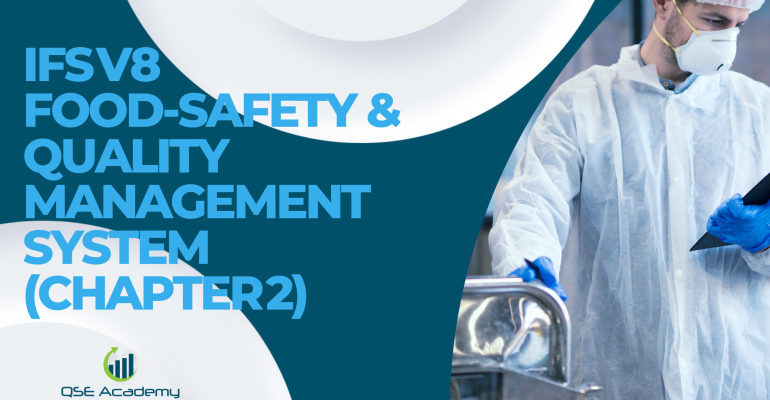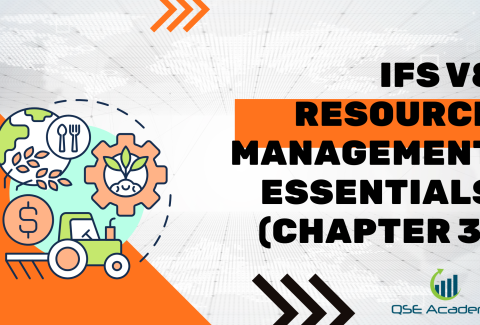IFS V8 Food‑Safety & Quality Management System (Chapter 2)
Last Updated on November 17, 2025 by Melissa Lazaro
Building a Practical and Audit-Ready FSQMS
When I walk into facilities preparing for an IFS audit, I often see the same situation: documents everywhere, forms no one uses, and a system that looks good on paper—but doesn’t really guide day-to-day work.
IFS V8 shifts the focus from “documentation for compliance” to documentation that supports control, consistency, and improvement. The standard expects your Food-Safety & Quality Management System (FSQMS) to be structured, functional, and integrated into operations—not a binder that only comes out before audits.
By the time you finish this, you’ll know:
- What a compliant FSQMS includes under IFS V8
- How to structure documentation so it works for people—not against them
- What evidence auditors expect
- The most common mistakes to avoid
- Practical ways to simplify the system without losing compliance
If your goal is to build a system that’s usable, efficient, and audit-ready year-round, this chapter is the foundation.
Defining the FSQMS — Scope, Process Mapping & System Foundation
Your FSQMS tells the story of how your business ensures food safety and product quality. Under IFS V8, that includes defining:
- What you make
- Where you make it
- Which processes impact food safety and quality
- How those processes are controlled
A good starting point is defining the scope. This includes products, technologies, sites, and legal frameworks. From there, map out core processes—production, quality checks, traceability, training, procurement, sanitation, and so on.
In my experience, companies that start with process mapping instead of document collection build better systems. Mapping forces clarity: Who does what? When? Under what controls?
Common mistake: teams create dozens of procedures without having clarity on the process flow. The result? Inconsistent practices and documentation gaps.
Pro Tip: Create one visual process map linking hazards, control measures, procedures, and records. Auditors love it, and operations finally see how the system fits together.
 Documentation Requirements — Procedures, Work Instructions & Proof of Implementation
Documentation Requirements — Procedures, Work Instructions & Proof of Implementation
IFS V8 expects documented information that:
- Describes what should happen
- Guides how tasks are performed
- Proves those tasks were completed correctly
Think of your documentation hierarchy like this:
| Level | Type | Purpose |
|---|---|---|
| 1 | Policies | Direction and intent |
| 2 | Procedures | Define what must be done and by whom |
| 3 | SOPs & Work Instructions | Explain exactly how tasks are performed |
| 4 | Forms, Templates & Records | Evidence of compliance |
A procedure doesn’t need to be six pages long. A one-page clear instruction is often better.
One manufacturer I worked with reduced documentation volume by over a third—and suddenly employees started following procedures because they finally made sense.
Pitfall: uncontrolled, outdated or duplicated documents. If operators aren’t sure which version is correct, the system isn’t functioning.
Document Control System — Versioning, Accessibility & Obsolete Copies
Document control protects the integrity of your system. It ensures everyone is using the right information—not whatever version they happen to find.
IFS V8 expects you to control:
- Version numbers
- Approval signatures
- Revision history
- Distribution lists
- Review frequency
- Obsolete-document management
If a printed procedure is used on the floor, it must match the digital version. If it doesn’t, auditors treat it as a nonconformity—because inconsistent instructions lead to inconsistent results.
Pro Tip: Add expiration or review dates to floor-posted documents. If there’s no review cycle visible, auditors assume it hasn’t been checked.
Records Management — Traceability, Legibility & Retention
Procedures tell people what to do—records prove they did it.
To meet IFS expectations, records must be:
- Completed in real time
- Legible, accurate, and permanent
- Signed or digitally verified
- Stored securely and retrievable
- Kept for a retention period aligned with shelf life, regulations, and customer expectations
A handwritten form with crossed-out text and no initials? That’s a red flag.
A back-dated record? That instantly erodes trust.
Common mistake: filing records but never reviewing them. Records aren’t just storage—they’re validation tools.
Control of Changes — Managing Risk When Making Adjustments
IFS expects organizations to assess and record the impact of changes such as:
- New raw materials
- Revised formulations
- Equipment upgrades
- Supplier changes
- Label changes
- Software or documentation updates
Change control isn’t bureaucracy—it’s protection. Uncontrolled changes are a known source of recalls.
Pro Tip: Link change control to HACCP review and training updates. When one changes, the others often should too.
Continual Improvement — KPIs, Trend Monitoring & CAPA Effectiveness
IFS V8 requires improvement to be measurable. That means using data—not assumptions—to evaluate how well your FSQMS performs.
Focus on:
- Complaint trends
- Recall simulations
- Customer audit results
- Internal audit findings
- Waste and rework
- CAPA completion and effectiveness
Small, consistent improvements prevent large failures later.
A useful question:
Does data trigger decisions—or just reporting?
If it’s only reporting, the system isn’t improving.
System Continuity — FSQMS Functioning Through Personnel & System Changes
A resilient FSQMS doesn’t depend on one expert or one system champion. It continues functioning even when someone is on leave or when processes change.
That means building in:
- Backup roles
- Training plans
- Cross-functional ownership
- Structured onboarding
IFS calls this organizational continuity. It’s how you protect the system from human risk.
FAQs
Do we need FSQMS software to comply with IFS V8?
No. Software can help—but paper systems are acceptable if they’re controlled, consistent, and traceable.
How detailed should SOPs be?
Detailed enough that a trained employee can perform the task reliably and consistently.
How often must documents be reviewed?
At least annually—or sooner if processes, equipment, or legal/customer requirements change.
Conclusion — Turning Documentation Into a Working System
A compliant FSQMS isn’t just paperwork—it’s a living system that supports safety, consistency, and operational discipline.
When documentation matches reality, employees understand the system, and leadership uses data to drive decisions—you’re not just audit-ready. You’re protected.
If you want support validating your FSQMS structure or need editable templates for Chapter 2, I can help you take the next step confidently and without guesswork.
Melissa Lavaro is a seasoned ISO consultant and an enthusiastic advocate for quality management standards. With a rich experience in conducting audits and providing consultancy services, Melissa specializes in helping organizations implement and adapt to ISO standards. Her passion for quality management is evident in her hands-on approach and deep understanding of the regulatory frameworks. Melissa’s expertise and energetic commitment make her a sought-after consultant, dedicated to elevating organizational compliance and performance through practical, insightful guidance.








